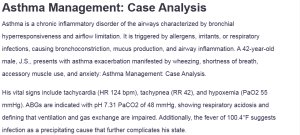Asthma Management: Case Analysis
Asthma is a chronic inflammatory disorder of the airways characterized by bronchial hyperresponsiveness and airflow limitation. It is triggered by allergens, irritants, or respiratory infections, causing bronchoconstriction, mucus production, and airway inflammation. A 42-year-old male, J.S., presents with asthma exacerbation manifested by wheezing, shortness of breath, accessory muscle use, and anxiety: Asthma Management: Case Analysis.
His vital signs include tachycardia (HR 124 bpm), tachypnea (RR 42), and hypoxemia (PaO2 55 mmHg). ABGs are indicated with pH 7.31 PaCO2 of 48 mmHg, showing respiratory acidosis and defining that ventilation and gas exchange are impaired. Additionally, the fever of 100.4°F suggests infection as a precipitating cause that further complicates his state.
The likely cause of J.S.’s exacerbation is exposure to allergens such as dust and pollen, to which he is highly allergic. These environmental exposures most likely exacerbated his airway inflammation and triggered bronchospasms. Additionally, a possible provoking factor is poorly controlled asthma with fluticasone/salmeterol or poor inhaler technique (Sinyor & Concepcion Perez, 2023).
Poor compliance with treatment and suboptimal management strategies constitutes another aspect of his condition. Changes in weather due to seasons in the Midwest may further aggravate his respiratory system and call for vigilant monitoring during the peak allergen seasons.
Given the emergency of the case with an acutely worsening state, there is an immediate need for intervention. J.S. would require supplemental oxygen to address the hypoxemia condition, systemic corticosteroids, and bronchodilators in order to decrease inflammation of the airway and relax the bronchial muscles. Fluid replacement intravenously, like D5W, shall be maintained to keep him hydrated and support systemic function (Hashmi & Cataletto, 2024). Also, an important part of the management will include educating the patient on the avoidance of known allergens, proper use of inhalers, and adherence to asthma management plans to avoid further exacerbations in the future.
The management of asthma is proactive, multifaceted, and based on early recognition of symptoms, adherence to treatment, and minimization of exposure to the triggers of the disease. Such strategies are also essential in preventing severe attacks and enhancing the overall quality of life for patients like J.S. Proactive follow-up visits with healthcare providers also ensure the best long-term control.
References
Hashmi, M. F., & Cataletto, M. E. (2024, May 3). Asthma. PubMed; StatPearls Publishing. https://www.ncbi.nlm.nih.gov/books/NBK430901/
Sinyor, B., & Concepcion Perez, L. (2023, June 24). Pathophysiology of asthma. PubMed; StatPearls Publishing. https://www.ncbi.nlm.nih.gov/books/NBK551579/
ORDER A PLAGIARISM-FREE PAPER HERE
We’ll write everything from scratch
Question 
Title of Assignment:
Module 08 Written Assignment – Asthma Management
Purpose of Assignment:
This assignment will help the student evaluate of a respiratory disorder, which, if untreated, can be a serious condition. Students need to understand respiratory complications and how it can impact ventilation and respiration is important to the study for maintaining homeostasis in the body.
Course Competency(s):
- Evaluate pathophysiologic alterations that affect the neurologic and respiratory systems.
Content:
J.S. is a 42-year-old man who lives in the Midwest and is highly allergic to dust and pollen and has a history of mild asthma. J.S’s wife drove him to the emergency room when his wheezing was unresponsive to his fluticasone/salmeterol (Advair) inhaler. J.S. was unable to lie down, and began to use accessory muscles to breathe. J.S. is immediately started on 4 L oxygen by nasal cannula and intravenous (IV) D5W at 75 mL/hr. A set of arterial blood gases is sent to the laboratory. J.S. appears anxious and says that he is short of breath.
Vital signs
BP = 152/84 HR = 124 bpm RR = 42 Temp = 100.40F
ABGs
pH = 7.31 PaCO2 = 48 HCO3 = 26 PaO2 = 55

Asthma Management: Case Analysis
Instructions:
Investigate the pathophysiology of asthma and the clinical manifestations of the disease. Analyze the case study provided and determine what symptoms support the diagnosis of asthma.
- Do you have any concerns with the numbers above?
- Identify what may be causing (etiology) J.S. to have an exacerbation of asthma.
Prepare a 1 page paper outlining the causes of asthma and the symptoms that the client presents. Use at least one scholarly source to support your findings. Examples of scholarly sources include academic journals, textbooks, reference texts, and CINAHL nursing guides. Be sure to cite your sources in-text and on a References page using APA format.
You can find useful reference materials for this assignment in the School of Nursing guide: https://guides.rasmussen.edu/nursing/referenceebooks
Have questions about APA? Visit the online APA guide: https://guides.rasmussen.edu/apa